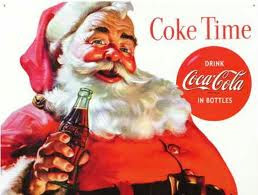Hmmm. Christmas topical ads.
For some reason I remembered this the other day. It got me thinking, apart from desperately wanting to open those doors, what goes into making a cracking topical ad?
Lynx 'Advent Calendar' by BBH
Naked flesh?
It's possibly all these. But the most important thing is a great campaign to bounce your idea off.
It's possibly all these. But the most important thing is a great campaign to bounce your idea off.
Lynx, Nike, Marmite, Kit Kat to mention just a few, all have fantastic campaigns that can quickly and seamlessly accommodate a topical ad.
Whereas brands that haven't committed to building a distinct campaign will always struggle.
So what is the greatest topical ad of them all?
If the conversations I've had in the past week are anything to go by, that's a big question. It started out as a bit of banter and ended up with people sending reams of links, stills and wandering in with old copies of D&AD and even topical ads that hadn't been made but lie dormant in the bottom draw.
Well I'm going to go against protocol here and jump straight in with the winner.
Nike 'Arsena' by W+K
It's genius. A perfect fit between Nike and the Arsenal team of 2003 / 2004. It ran the day after they'd remained undefeated for a whole season. It is beautiful in concept and execution. For such an historic achievement it's brilliantly humble. I remember seeing it as a strip ad in the Evening Standard. Only once. But it was seared into my brain. Like Sir John Heg says, you don't need to run an ad to death spending millions on media. If you run an ad just once and it's good enough it'll work (I'm sure he said it much more elegantly than that).
As a Man Utd fan it pains me to praise such an ad. And yes, I am aware in the history of topical ads, no one has devoted more time and effort than the footy obsessed creative. And being our national sport, why not?
There were other contenders, see below. And others that couldn't be traced - most notably a very old press ad for Sainsbury's on budget day. Norman Lamont coming out of No. 10 with a Sainsbury's carrier bag with its then endline 'Good food costs less at Sainsbury's'. The headline read 'No surprises so far.'
Amid the banter and debate, there was consensus that there is a difference between a topical ad and a tactical ad.
A pure topical ad is of the moment. An event occurs. A creative writes the ad in the shower / on the bog / on the way to work. And then he/she starts desperately trying to get it approved by CD, client and placed in the media for the next morning. A nice recent example is this bicycle ad for the riots, from those lovely chaps at BETC London.
Micycle 'Looters' by BETC London
The ad appeared in the press the next day with seeming ease, but I bet there were a whole lot of people paddling madly under the water to get it done.
By their nature topical ads are reactive. Something unusual has to happen, such as Britney Spears' bizarre 55-hour marriage (Did she fart in bed? Did he refuse to take his socks off?), so that Lynx could jump on it and create a brilliant press ad the following day that rightly found itself in D&AD.
Lynx 'Britney' by BBH
Lynx 'Britney' by BBH
Tactical ads feel a little more planned in their nature. A good example is the 'St Wayne' poster by W+K for Nike before the South Africa World Cup. A shoot was planned, bit of retouching done and lots of lovely media booked. It was the best thing the Roo managed that summer.
Nike 'St Wayne' by W+K
And the online version where Rooney is holding Ronaldo's head was even better and was probably more of a topical ad... of the tactical ad. Or was it a viral ad of the tactical ad?
So the contenders, in a very loose order....
'Chris Christmas' from Mother
Polo 'Stamp' by JWT
Ministry of Defence in Colombia 'Operation Christmas' by LoweSSP3 Bogota
Nike 'Y2K Jogger' by W+K
Conservative Party 'Labour isn't working' by Saatchi & Saatchi
Speechbreaker by Lean Mean Fighting Machine
Saatchi in-house ad when the Berlin Wall came down
Hamlet 'Botham' by CDP
Beefy Botham was caught smoking hash. The next day Hamlet ran this.
Can you imagine trying to convince a client to do that today...
 |
Hamlet 'C4 Ident' by CDP
18-30 'Bush' by Saatchi & Saatchi

FHM 'Beckham' by BBH
And finally back to the beginning. Is this the greatest Christmas stunt of all time? Father Christmas being turned red and white by Coke in the fifties.
Thanks everyone who chipped in, esp Henry at the NMA.
Please feel free to agree / disagree or offer up your own topical ads...
















